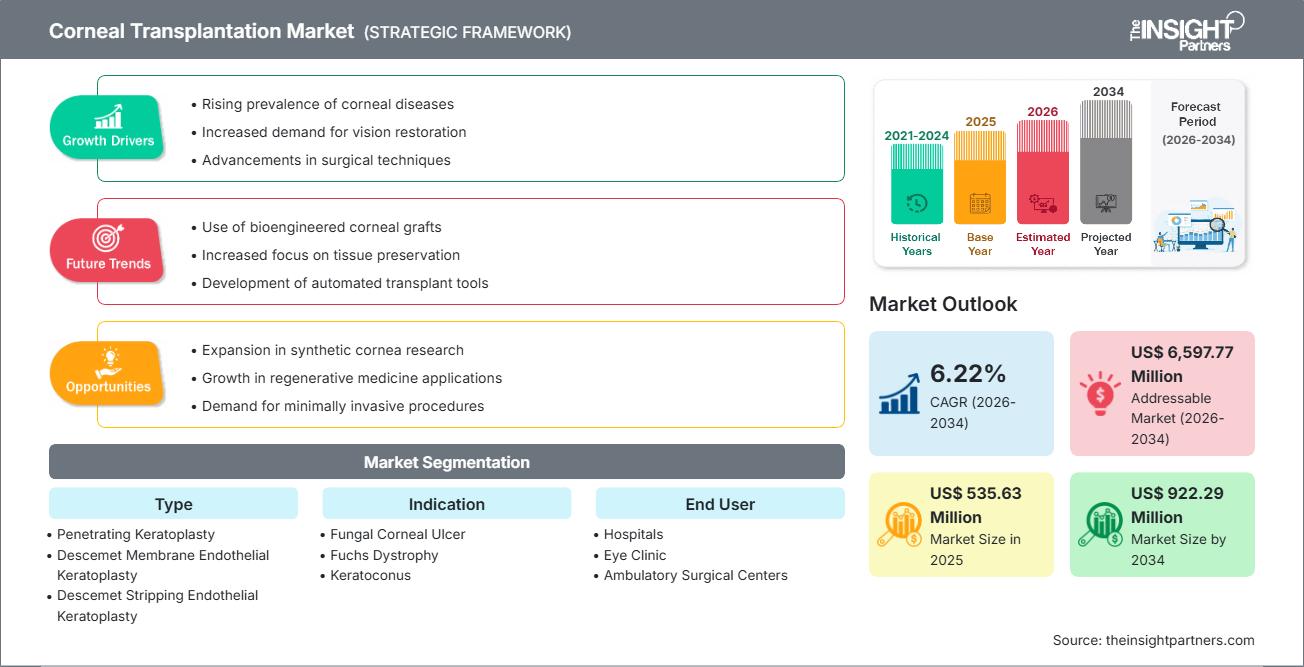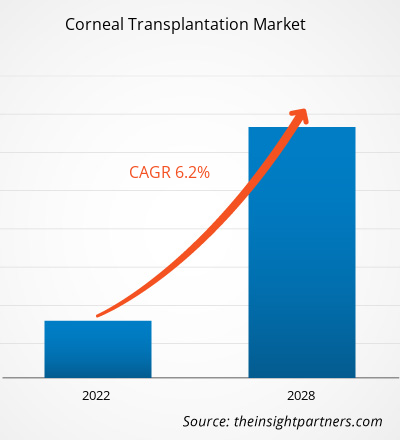Es wird erwartet, dass der Markt für Hornhauttransplantationen bis 2034 ein Volumen von 922,29 Millionen US-Dollar erreichen wird, gegenüber 535,63 Millionen US-Dollar im Jahr 2025. Für den Zeitraum 2026–2034 wird ein durchschnittliches jährliches Wachstum von 6,22 % prognostiziert.
Marktanalyse für Hornhauttransplantationen
Der Markt für Hornhauttransplantationen wächst rasant, vor allem aufgrund der zunehmenden Verbreitung von Hornhauterkrankungen wie Keratokonus, Fuchs-Endotheldystrophie und infektiöser Keratitis sowie der wachsenden Zahl älterer Menschen. Fortschritte in der Operationstechnik, darunter die Descemet-Membran-Endothelkeratoplastik (DMEK) und die Femtosekundenlaser-assistierte Chirurgie, verbessern die Präzision und die Behandlungsergebnisse und treiben so das Marktwachstum an. Der Markt umfasst Verfahren mit menschlichen Spenderhornhäuten sowie künstlichen Hornhäuten/Implantaten, deren Nachfrage aufgrund des anhaltenden weltweiten Mangels an menschlichen Spenderhornhäuten steigt. Führende Akteure konzentrieren sich auf Forschung und Entwicklung, um die Spenderfähigkeit zu verbessern und innovative biotechnologisch hergestellte und synthetische Implantate zu entwickeln. Es wird erwartet, dass der Markt weiter wächst, sobald das Bewusstsein für die Augenspende zunimmt und sich die Gesundheitsinfrastruktur, insbesondere in Schwellenländern, verbessert.
Marktübersicht zur Hornhauttransplantation
Die Hornhauttransplantation, auch Keratoplastik genannt, ist ein chirurgischer Eingriff, bei dem eine geschädigte oder erkrankte Hornhaut durch eine gesunde Spenderhornhaut (oder ein künstliches Implantat) ersetzt wird. Sie zählt zu den häufigsten und erfolgreichsten Formen der Gewebetransplantation beim Menschen. Der Eingriff ist unerlässlich, um Sehverlust infolge von Hornhauterkrankungen, Narbenbildung oder Traumata zu verhindern. Moderne Techniken, wie die endotheliale Keratoplastik (DSEK/DMEK), zielen darauf ab, nur die erkrankten Schichten zu ersetzen. Diese Verfahren bieten im Vergleich zur traditionellen perforierenden Keratoplastik (PK) eine schnellere Genesung und ein geringeres Abstoßungsrisiko. Die zunehmende Verfügbarkeit und Akzeptanz dieser spezialisierten lamellären Verfahren sind Schlüsselfaktoren für die Marktentwicklung. Eine große Herausforderung bleibt der weltweite Mangel an menschlichen Spenderhornhäuten, der Investitionen in die Entwicklung künstlicher Hornhäute fördert.
Passen Sie diesen Bericht Ihren Anforderungen an.
Sie erhalten eine kostenlose Anpassung aller Berichte – einschließlich Teilen dieses Berichts, Länderanalysen und Excel-Datenpaketen – sowie attraktive Angebote und Rabatte für Start-ups und Universitäten.
Markt für Hornhauttransplantation: Strategische Einblicke

-
Ermitteln Sie die wichtigsten Markttrends dieses Berichts.Diese KOSTENLOSE Probe beinhaltet eine Datenanalyse, die von Markttrends bis hin zu Schätzungen und Prognosen reicht.
Markttreiber und Chancen der Hornhauttransplantation
Markttreiber:
- Zunehmende Verbreitung von Hornhauterkrankungen: Erkrankungen wie Keratokonus, Fuchs-Endotheldystrophie und infektiöse Keratitis sind Hauptursachen für Hornhautblindheit und treiben die Nachfrage nach Transplantationsverfahren direkt an.
- Fortschritte bei den chirurgischen Techniken: Der Trend hin zu lamellären Teildickenverfahren wie DMEK und DSAEK verbessert die postoperative Sehschärfe und verkürzt die Erholungszeit, was die Anwendung dieser Verfahren fördert.
- Zunehmende ältere Bevölkerung: Die alternde Weltbevölkerung ist anfälliger für altersbedingte Hornhauterkrankungen wie die Fuchs-Endotheldystrophie, was zu einer höheren Anzahl von Transplantationskandidaten führt.
- Zunehmendes Bewusstsein und Initiativen zur Augenspende: Kampagnen im Bereich der öffentlichen Gesundheit und organisierte Bemühungen um die Einlagerung von Augengewebe erhöhen die Verfügbarkeit menschlicher Spenderhornhäute in verschiedenen Regionen.
Marktchancen:
- Entwicklung künstlicher Hornhäute (Keratoprothesen): Der gravierende weltweite Mangel an menschlichen Spenderhornhäuten bietet Unternehmen, die synthetische (z. B. PMMA) und bio-ingenieurtechnisch hergestellte Implantate entwickeln, eine bedeutende Chance, die große ungedeckte Nachfrage zu befriedigen.
- Expansion in Schwellenländern: Schnelle Verbesserungen der Gesundheitsinfrastruktur, steigende verfügbare Einkommen und die hohe Belastung durch infektiöse Keratitis in Ländern wie China und Indien schaffen riesige, bisher ungenutzte Möglichkeiten für Anbieter von Hornhauttransplantationen.
- Innovative Gewebekonservierung und -lieferung: Lösungen, die die Lebensfähigkeit von Spenderhornhäuten verlängern und die logistische Effizienz beim internationalen Gewebeaustausch verbessern können, können der Herausforderung des Spendermangels begegnen.
- Verstärkter Fokus auf minimalinvasive Verfahren: Weitere Innovationen bei lasergestützten und minimalinvasiven Techniken werden die Sicherheit, die Vorhersagbarkeit der Ergebnisse und die Patientenpräferenz weiter verbessern.
Marktbericht zur Hornhauttransplantation: Segmentierungsanalyse
Der Marktanteil der Hornhauttransplantation wird in verschiedenen Segmenten analysiert, um ein besseres Verständnis ihrer Struktur, ihres Wachstumspotenzials und der sich abzeichnenden Trends zu ermöglichen. Nachfolgend ist der in den meisten Branchenberichten verwendete Standardansatz zur Segmentierung dargestellt:
Nach Typ
- Perforierende Keratoplastik
- Descemet-Membran-Endothelkeratoplastik
- Descemet-Stripping-Endothelkeratoplastik
- Hornhaut-Limbus-Stammzelltransplantation
Nach Angabe
- Keratokonus: Fortschreitende Ausdünnung und Vorwölbung der Hornhaut.
- Pilzbedingtes Hornhautgeschwür
- Fuchs-Muskeldystrophie
- Keratokonus
- Keratitis
Vom Endbenutzer
- Krankenhäuser
- Augenkliniken
- Ambulante Operationszentren
Nach Geographie
- Nordamerika
- Europa
- Asien-Pazifik
- Süd- und Mittelamerika
- Naher Osten und Afrika
Regionale Einblicke in den Markt für Hornhauttransplantation
Die regionalen Trends und Einflussfaktoren auf den Markt für Hornhauttransplantationen im gesamten Prognosezeitraum wurden von den Analysten von The Insight Partners eingehend erläutert. Dieser Abschnitt behandelt außerdem die Marktsegmente und die geografische Verteilung des Hornhauttransplantationsmarktes in Nordamerika, Europa, Asien-Pazifik, dem Nahen Osten und Afrika sowie Süd- und Mittelamerika.
Berichtsumfang zum Markt für Hornhauttransplantation
| Berichtattribute | Details |
|---|---|
| Marktgröße im Jahr 2025 | 535,63 Millionen US-Dollar |
| Marktgröße bis 2034 | 922,29 Millionen US-Dollar |
| Globale durchschnittliche jährliche Wachstumsrate (2026 - 2034) | 6,22 % |
| Historische Daten | 2021-2024 |
| Prognosezeitraum | 2026–2034 |
| Abgedeckte Segmente |
Nach Typ
|
| Abgedeckte Regionen und Länder |
Nordamerika
|
| Marktführer und wichtige Unternehmensprofile |
|
Marktdichte im Bereich der Hornhauttransplantation: Auswirkungen auf die Geschäftsdynamik verstehen
Der Markt für Hornhauttransplantationen wächst rasant, angetrieben durch die steigende Nachfrage der Endverbraucher. Gründe hierfür sind unter anderem sich wandelnde Verbraucherpräferenzen, technologische Fortschritte und ein wachsendes Bewusstsein für die Vorteile des Produkts. Mit steigender Nachfrage erweitern Unternehmen ihr Angebot, entwickeln innovative Lösungen, um den Bedürfnissen der Verbraucher gerecht zu werden, und nutzen neue Trends, was das Marktwachstum zusätzlich beflügelt.

- Verschaffen Sie sich einen Überblick über die wichtigsten Akteure des Marktes für Hornhauttransplantation.
Marktanteilsanalyse für Hornhauttransplantationen nach Regionen
Nordamerika dominierte den Markt für Hornhauttransplantationen hinsichtlich des Umsatzanteils. Diese Dominanz ist auf eine leistungsfähige Gesundheitsinfrastruktur, ein hohes Bewusstsein für Augenspenden, die weitverbreitete Anwendung fortschrittlicher chirurgischer Technologien und die Präsenz führender Organisationen für ophthalmologische Geräte und Augenbanken zurückzuführen. Die USA halten den größten Marktanteil innerhalb der Region.
1. Nordamerika
- Marktanteil: Besitzt den größten Marktanteil, was auf ein gut etabliertes Augenbankensystem und die hohe Akzeptanz anspruchsvoller Verfahren (DMEK/DSAEK) zurückzuführen ist.
-
Wichtigste Einflussfaktoren:
- Hohes Vorkommen von Fuchs-Endotheldystrophie und Keratokonus.
- Präsenz wichtiger Marktteilnehmer und eines robusten F&E-Ökosystems.
- Günstige Erstattungspolitik für komplexe Augenoperationen.
- Trends: Kontinuierlicher Trend hin zur lamellären Keratoplastik und zunehmender Einsatz von künstlichen Implantaten bei komplexen Fällen.
2. Europa
- Marktanteil: Bedeutender Marktanteil, gestützt durch universelle Gesundheitssysteme und einen Fokus auf fortschrittliche Medizintechnologien.
-
Wichtigste Einflussfaktoren:
- Starker Fokus auf Qualitätskontrolle und Standardisierung der Abläufe bei der Augenbank und den chirurgischen Protokollen.
- Hohe Prävalenz altersbedingter Hornhauterkrankungen.
- Investitionen in technologische Fortschritte für künstliche Hornhäute.
- Trends: Zunahme spezialisierter Kliniken für lamelläre Keratoplastik und zunehmende Verbreitung neuerer künstlicher Hornhautmodelle.
3. Asien-Pazifik
- Marktanteil: Am schnellsten wachsender regionaler Markt, angetrieben durch große Patientenpopulationen und einen verbesserten Zugang zur Gesundheitsversorgung.
-
Wichtigste Einflussfaktoren:
- Zunehmende Verbreitung von Augenkrankheiten, darunter eine hohe Belastung durch infektiöse Keratitis, die zu Hornhautnarben führt.
- Staatlich geförderte Modernisierung des Gesundheitswesens und Ausbau der augenärztlichen Einrichtungen.
- Steigerung des Bewusstseins für Augengesundheit und Organspende in bevölkerungsreichen Ländern wie Indien und China.
- Trends: Deutliche Investitionen in lokale Augenbanken und ein rascher Anstieg der Anzahl durchgeführter Transplantationen.
4. Süd- und Mittelamerika
- Marktanteil: Aufstrebende Region mit zunehmender Akzeptanz.
-
Wichtigste Einflussfaktoren:
- Zunehmende Häufigkeit von Augeninfektionen und Hornhautverletzungen.
- Ausbau erschwinglicher Gesundheitsdienstleistungen und des Medizintourismus.
- Trends: Fokus auf die Verbesserung der Infrastruktur von Augenbanken und die Zusammenarbeit mit internationalen Augenbanken zur Gewinnung von Spendergewebe.
5. Naher Osten und Afrika
- Marktanteil: Aufstrebender Markt mit starkem Wachstumspotenzial, angetrieben durch die digitale Transformation und die Gesundheitsausgaben in Ländern wie den Vereinigten Arabischen Emiraten und Saudi-Arabien.
-
Wichtigste Einflussfaktoren:
- Wichtige nationale Gesundheitsinitiativen mit Schwerpunkt auf spezialisierter Versorgung.
- Hohe Raten an Augenverletzungen und -infektionen.
- Trends: Einrichtung lokaler Augenbanken und Übernahme internationaler Best Practices für die Hornhauttransplantation.
Marktdichte im Bereich der Hornhauttransplantation: Auswirkungen auf die Geschäftsdynamik verstehen
Der Wettbewerb auf dem Markt für Hornhauttransplantationen wird sowohl von Anbietern menschlichen Gewebes (Augenbanken) als auch von Herstellern medizinischer Geräte bestimmt, die sich auf chirurgische Instrumente und künstliche Hornhäute konzentrieren.
Der Wettbewerb ist intensiv, die Spieler unterscheiden sich durch Folgendes:
- Augenbanken konkurrieren über die Qualität und ethische Beschaffung von Spendergewebe, die Verlängerung der Gewebelebensfähigkeit und effiziente Vertriebsnetze.
- Die Gerätehersteller konzentrieren sich auf die Entwicklung fortschrittlicher künstlicher Hornhäute und spezialisierter chirurgischer Instrumente, um die Behandlungsergebnisse für Patienten zu verbessern und dem Spenderengpass entgegenzuwirken.
- Unternehmen kooperieren mit Chirurgen, um sie in den neuesten, technisch anspruchsvollen lamellären Verfahren (DMEK) zu schulen, was für die Marktakzeptanz von entscheidender Bedeutung ist.
Chancen und strategische Schritte
- Strategische Partnerschaften: Kooperationen zwischen Augenbanken und Forschungs- und Entwicklungsunternehmen zur Erprobung und Vermarktung neuartiger Konservierungslösungen oder künstlicher Gewebeersatzstoffe.
- Expansion bei Hornhautimplantaten: Erhebliche Investitionen fließen in Unternehmen, die synthetische Hornhäute entwickeln, um den Engpass bei der Versorgung mit menschlichen Spenderhornhäuten zu umgehen und ein stabiles und vorhersehbares Produkt anzubieten.
- Fusionen und Übernahmen: Größere Medizintechnikunternehmen erwerben spezialisierte Hersteller von chirurgischen Instrumenten und Implantaten, um Chirurgen umfassende Verfahrenslösungen anbieten zu können.
Die wichtigsten Unternehmen, die auf dem Markt für Hornhauttransplantationen tätig sind, sind:
- CorneaGen
- Alcon Inc.
- Florida Lions Eye Bank
- Hornhautsehen
- Aurolab
- KERAMED, INC.
- CORNEA BIOSCIENCES, INC.
- Augenmedizin
- Massachusetts Eye and Ear
Hinweis: Die oben aufgeführten Unternehmen sind nicht in einer bestimmten Reihenfolge geordnet.
Neuigkeiten und aktuelle Entwicklungen auf dem Markt für Hornhauttransplantationen
- Am 2. September 2025 verkündete CorNeat Vision, ein innovatives Unternehmen für ophthalmologische Medizintechnik, einen bahnbrechenden klinischen Erfolg: die Wiederherstellung des Sehvermögens bei einem Patienten, der durch Hornhautnarben infolge einer Gürtelrose erblindet war. Dank der künstlichen Hornhaut CorNeat KPro des Unternehmens erlangte der Patient eine perfekte Sehschärfe (6/6 bzw. 20/20) zurück, die elf Monate nach der Operation stabil ist. Neben der beeindruckenden funktionellen Verbesserung führte der Eingriff zu einer bemerkenswerten ästhetischen Transformation: Das Auge, das zuvor sichtbar von der Gürtelrose gezeichnet war, sieht nun erstaunlich natürlich und gesund aus.
- Am 26. März 2025 gab Alcon, der weltweit führende Anbieter von Augenheilkunde mit dem Ziel, Menschen zu besserem Sehen zu verhelfen, bekannt, dass er die Mehrheitsbeteiligung an Aurion Biotech, Inc. erworben hat, einem Unternehmen im klinischen Stadium, das fortschrittliche Zelltherapien zur Behandlung von Augenkrankheiten entwickelt.
- Im Juni 2024 kündigt CorneaGen die Markteinführung von Corneal Tissue Addition for Keratoplasty (CTAK) an, einer innovativen und äußerst effektiven Lösung zur Hornhautkonturierung bei Keratokonus-Augen.
Bericht zum Markt für Hornhauttransplantation: Abdeckung und Ergebnisse
Der Bericht „Marktgröße und Prognose für die Hornhauttransplantation (2021–2034)“ bietet eine detaillierte Analyse des Marktes und deckt folgende Bereiche ab:
- Marktgröße und Prognose für die Hornhauttransplantation auf globaler, regionaler und Länderebene für alle wichtigen Marktsegmente, die im Rahmen des Berichts abgedeckt werden
- Trends im Markt für Hornhauttransplantationen sowie Marktdynamiken wie Treiber, Hemmnisse und wichtige Chancen
- Detaillierte PEST- und SWOT-Analyse
- Marktanalyse zur Hornhauttransplantation: Wichtige Markttrends, globale und regionale Rahmenbedingungen, Hauptakteure, regulatorische Bestimmungen und aktuelle Marktentwicklungen
- Branchenlandschaft und Wettbewerbsanalyse mit Fokus auf Marktkonzentration, Heatmap-Analyse, führende Akteure und aktuelle Entwicklungen im Markt für Hornhauttransplantationen. Ausführliche Unternehmensprofile.
- Historische Analyse (2 Jahre), Basisjahr, Prognose (7 Jahre) mit CAGR
- PEST- und SWOT-Analyse
- Marktgröße Wert/Volumen – Global, Regional, Land
- Branchen- und Wettbewerbslandschaft
- Excel-Datensatz
Aktuelle Berichte
Erfahrungsberichte
Grund zum Kauf
- Fundierte Entscheidungsfindung
- Marktdynamik verstehen
- Wettbewerbsanalyse
- Kundeneinblicke
- Marktprognosen
- Risikominimierung
- Strategische Planung
- Investitionsbegründung
- Identifizierung neuer Märkte
- Verbesserung von Marketingstrategien
- Steigerung der Betriebseffizienz
- Anpassung an regulatorische Trends






















 Kostenlose Probe anfordern für - Markt für Hornhauttransplantationen
Kostenlose Probe anfordern für - Markt für Hornhauttransplantationen